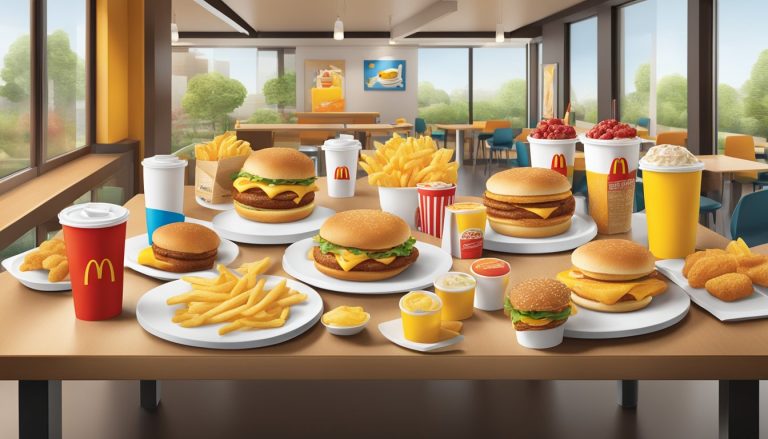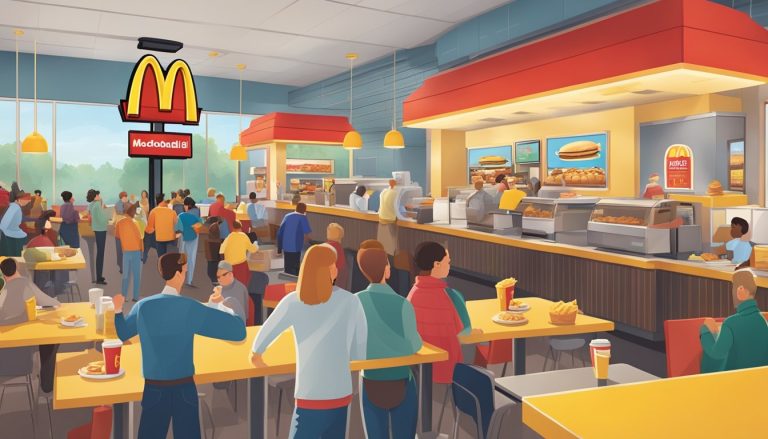McDonald’s breakfast packaging has a significant environmental impact due to its widespread use and disposal. The fast-food giant serves millions of customers daily, generating substantial amounts of waste from packaging materials like wrappers, containers, and cups.
McDonald’s is taking steps to reduce its environmental footprint by sourcing 86.7% of its primary packaging from renewable, recycled, or certified sources as of 2023. This initiative aims to decrease reliance on virgin materials and promote more sustainable packaging options. The company is also exploring alternative materials and redesigning packaging to minimize waste.
While progress has been made, challenges remain in achieving fully sustainable breakfast packaging. Balancing food safety, convenience, and environmental concerns requires ongoing innovation and commitment. As McDonald’s continues to evolve its packaging strategy, consumers and environmental advocates alike will be watching closely to see how the company addresses this critical issue.
McDonald’s Global Footprint and Environmental Responsibility

McDonald’s vast global presence comes with significant environmental responsibilities. The company has implemented sustainability initiatives and set ambitious goals to reduce its ecological impact across its operations and supply chains.
Understanding the Scale of McDonald’s Operations
McDonald’s serves millions of customers daily in over 100 countries. This massive scale translates to substantial resource consumption and waste generation. The company uses large quantities of packaging materials, especially for breakfast items. Its global supply chain involves sourcing ingredients from thousands of suppliers worldwide.
McDonald’s recognizes the need to address its environmental footprint. The company has committed to sourcing 100% of its guest packaging from renewable, recycled, or certified sources by the end of 2025. This initiative aims to reduce reliance on virgin materials and minimize waste.
Corporate Sustainability Goals
McDonald’s has set clear sustainability targets to guide its environmental efforts. The company pledged to achieve net-zero greenhouse gas emissions globally by 2050. This ambitious goal demonstrates McDonald’s commitment to combating climate change.
To reach this target, McDonald’s is focusing on several key areas:
- Reducing emissions in restaurant operations
- Engaging suppliers to lower emissions in supply chains
- Transitioning to more sustainable packaging materials
- Improving waste management and recycling practices
The company joined the United Nations’ Race to Zero campaign, aligning its efforts with global climate action initiatives. McDonald’s also aims to improve its impact on nature by promoting sustainable agriculture and responsible sourcing practices.
Packaging Consumption and Waste Generation
McDonald’s breakfast packaging contributes significantly to the company’s overall waste generation. The materials used, their environmental impact, and the balance between functionality and sustainability present ongoing challenges.
Types of Packaging Materials Used
McDonald’s breakfast packaging typically includes paper wrappers, cardboard boxes, plastic lids, and foam containers. Paper-based items like wrappers and boxes are often lined with plastic for grease resistance. Plastic is used for drink lids, straws, and some food containers. Foam packaging, while less common now, is still used in some markets for hot beverages.
These materials vary in recyclability. Paper products are generally easier to recycle, while plastic and foam pose greater challenges. The mix of materials in a single package (e.g. paper with plastic lining) can complicate recycling efforts.
Contribution to Global Waste
McDonald’s vast scale means its packaging has a significant environmental footprint. Breakfast items alone generate millions of pieces of waste daily. Much of this packaging ends up in landfills or as litter.
The company’s global presence amplifies its waste impact. In areas with limited recycling infrastructure, McDonald’s packaging is more likely to become environmental pollution. Plastic items pose particular concerns due to their long decomposition time.
McDonald’s has set goals to improve packaging sustainability, aiming for 100% renewable, recycled, or certified sources by 2025. Progress towards this target varies by region and material type.
Packaging Design and Guest Experience
McDonald’s balances functionality, food safety, and guest experience in its packaging design. Breakfast items require packaging that maintains food temperature and prevents leaks. This often leads to multi-layer or composite materials.
The company has explored innovations like fiber-based packaging to replace some plastic items. However, changes must not compromise food quality or customer satisfaction. Drive-thru and takeout services, which are popular for breakfast, add complexity to packaging choices.
McDonald’s also considers visual appeal in its packaging. Branded wrappers and boxes serve marketing purposes. The challenge lies in creating attractive, functional packaging that also meets sustainability goals.
Sustainable Packaging Strategies
McDonald’s is implementing multi-faceted approaches to reduce the environmental impact of its breakfast packaging. These strategies focus on material sourcing, partnerships, and innovative design solutions.
Transitioning to Sustainable Materials
McDonald’s aims to source 100% of its guest packaging from renewable, recycled, or certified sources by 2025. The company has made significant progress, with nearly 83% of primary guest packaging materials and 97% of primary fiber packaging sourced from recycled or certified sources by the end of 2021.
Fiber-based packaging is a key focus. McDonald’s is increasing the use of recycled content and exploring alternative materials like molded fiber to replace virgin fossil fuel-based plastics.
Bioplastics are being tested as a more eco-friendly option for certain packaging items. These materials can often be composted, reducing waste sent to landfills.
Collaboration with Environmental Organizations
McDonald’s partners with environmental organizations to enhance its sustainability efforts. These collaborations provide expertise and guidance on best practices for sustainable packaging.
Joint initiatives focus on improving recycling infrastructure and educating consumers about proper waste disposal. Partners help McDonald’s identify innovative materials and technologies that align with sustainability goals.
These partnerships also involve setting and monitoring progress towards specific targets, ensuring accountability and continuous improvement in packaging sustainability.
Innovations in Packaging Design
McDonald’s is redesigning its breakfast packaging to minimize material use while maintaining food safety and quality. New designs prioritize easy recyclability and use of sustainable materials.
Packaging innovations include:
- Reduced plastic content in utensils and straws
- Simplified packaging structures for easier recycling
- Increased use of single-material designs to improve recyclability
- Testing of reusable packaging systems for certain menu items
These design changes aim to reduce overall waste and increase the percentage of packaging that can be effectively recycled or composted.
Recycling Efforts and Challenges
McDonald’s has implemented various recycling initiatives to address packaging waste, with a focus on guest packaging and improving recyclability. These efforts face challenges in adapting to local recycling capabilities and reducing contamination in recycling streams.
Guest Packaging Recycling Initiatives
McDonald’s aims to source 100% of guest packaging from renewable, recycled, or certified sources by 2025. The company has standardized packaging designs worldwide to simplify recycling systems. New recycling labels and bins have been introduced to educate customers on proper disposal methods.
In 2023, 88.3% of McDonald’s restaurants in markets with advanced recycling infrastructure offered customers the opportunity to recycle or compost packaging items. This initiative supports the company’s goal of recycling guest packaging in all McDonald’s restaurants by 2025.
McDonald’s has phased out polystyrene cups and clamshells globally, completing this transition by the end of 2018. This move came after pressure from environmental groups and aligns with the company’s commitment to more sustainable packaging options.
Adapting to Local Recycling Capabilities
McDonald’s faces challenges in implementing uniform recycling practices due to varying local recycling capabilities. The company works to tailor its recycling programs to fit the infrastructure of different regions.
In areas with advanced recycling systems, McDonald’s can offer more comprehensive recycling options. However, in locations with limited recycling facilities, the company must adapt its strategies to maximize waste diversion within existing constraints.
To address these differences, McDonald’s collaborates with local waste management authorities and recycling facilities. This cooperation helps identify the most effective ways to recycle packaging materials in each area.
Reducing Contamination in Recycling Streams
Contamination in recycling streams poses a significant challenge to McDonald’s recycling efforts. Food residue on packaging can render otherwise recyclable materials unsuitable for processing.
To combat this issue, McDonald’s has implemented several strategies:
- Clear signage and instructions for customers on how to separate recyclables from food waste
- Training staff to properly sort waste and recyclables
- Redesigning packaging to minimize food residue
The company also explores innovative packaging solutions that are easier to clean or separate for recycling. These efforts aim to increase the overall recyclability of McDonald’s packaging and improve recycling rates across its global operations.
Impact Mitigation Through Resource Management

McDonald’s is taking concrete steps to reduce its environmental footprint through strategic resource management. The company is focusing on decreasing non-renewable resource usage and promoting circular economy principles in its operations.
Reductions in Non-Renewable Resource Use
McDonald’s has made significant progress in reducing its reliance on non-renewable resources. By late 2023, the company sourced 86.7% of its primary packaging from renewable or recycled materials. This shift includes replacing plastic items with fiber-based alternatives, which now comprise 78% of their global packaging weight.
The fast-food giant is also exploring innovative packaging designs to minimize material use. These efforts extend to their toy production, with a commitment to more sustainable materials. McDonald’s is actively working to decrease its carbon footprint through these initiatives.
Fostering a Circular Economy
McDonald’s is implementing strategies to create a more circular system for its packaging. The company is redesigning packaging to be more easily recyclable and exploring alternative materials that can be reused or composted.
Key initiatives include:
- Enhancing recovery opportunities for used packaging
- Partnering with suppliers to develop closed-loop recycling systems
- Educating customers on proper waste disposal
These efforts aim to keep materials in use for longer periods, reducing overall waste generation. McDonald’s is also investing in renewable energy sources for its restaurants, further supporting the transition to a circular economy model.
Corporate Partnerships and Certifications

McDonald’s collaborates with environmental organizations and pursues certifications to improve its sustainability practices. These efforts focus on reducing packaging waste and sourcing materials responsibly.
Working with Global Environmental Advocates
McDonald’s partners with the World Wildlife Fund to address environmental challenges. This collaboration aims to minimize the company’s ecological footprint, particularly in packaging and waste reduction. The environmental defense fund also works with McDonald’s to develop strategies for sustainable sourcing and emissions reduction.
McDonald’s participates in the Bioplastic Feedstock Alliance, exploring alternatives to conventional plastics. This initiative seeks to create more environmentally friendly packaging materials. Arcos Dorados, McDonald’s largest franchisee in Latin America, implements sustainability programs aligned with global corporate goals.
Achieving Certifications for Sustainability
The Forest Stewardship Council (FSC) certifies McDonald’s paper and board packaging. This certification ensures materials come from responsibly managed forests. McDonald’s aims to source 100% of its fiber-based packaging from recycled or certified sources.
The company has made progress toward this goal, with approximately 82.7% of primary guest packaging now sourced sustainably. McDonald’s also works to reduce virgin fossil fuel-based plastic in Happy Meal toys, achieving a 24.4% reduction since 2018.
Certifications help McDonald’s validate its sustainability efforts and demonstrate commitment to environmental protection. These standards guide the company’s packaging choices and material sourcing practices.
Further Initiatives and Community Engagement

McDonald’s has expanded its sustainability efforts beyond internal operations. The company now focuses on educating consumers and implementing local waste management programs to maximize impact.
Educating Consumers on Sustainable Choices
McDonald’s has launched campaigns to inform customers about eco-friendly packaging options. In-store signage highlights recyclable and compostable materials used in cups, wrappers, and containers.
The company’s mobile app now includes a “Green Choices” section. This feature allows users to opt for more sustainable packaging when placing orders.
McDonald’s website provides detailed information on proper disposal methods for different packaging items. This helps customers make informed decisions about recycling and waste reduction.
Local Level Waste Management Programs
McDonald’s partners with local governments to establish recycling stations near restaurants. These stations accept packaging waste and sort materials for proper recycling.
The company has piloted composting programs in select cities. Food scraps and compostable packaging are collected and processed into nutrient-rich soil for community gardens.
McDonald’s collaborates with schools to organize litter clean-up events. These initiatives raise awareness about proper waste disposal and environmental stewardship among young people.
In some locations, McDonald’s offers incentives for customers who bring reusable containers. This program aims to reduce single-use packaging waste and encourage sustainable habits.




